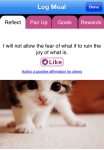App-ily building bridges in eating disorder care and recovery
App-ily building bridges in eating disorder care and recovery
The Internet is fast filling gaps in eating disorder prevention, treatment and recovery.
Recovery Record and Proud2Bme will be the subject of a concurrent session ‘Building Bridges Not Walls’ at this year’s NEDA Conference. Both are outstanding examples of how technology is helping people everywhere to connect and improve their lives with online support.
Presenters Jenna Tregarthen, co-founder of Recovery Record, and Claire Mysko, Proud2Bme manager, describe why their work is important:
Recovery Record (Jenna Tregarthen)
 Recovery Record reinvents traditional paper-based cognitive behavioral therapy self-monitoring with a secure and discrete iPhone and Android app for people living with an eating disorder. The app facilitates ‘recovery on the go’ with meal monitoring, rewards, and smart algorithms that suggest coping tactics in the moments they are needed.
Recovery Record reinvents traditional paper-based cognitive behavioral therapy self-monitoring with a secure and discrete iPhone and Android app for people living with an eating disorder. The app facilitates ‘recovery on the go’ with meal monitoring, rewards, and smart algorithms that suggest coping tactics in the moments they are needed.
People with eating disorders can also co-manage treatment by linking their Recovery Record app with their clinician’s Recovery Record Clinician app, available from October 1st this year.
This app enables clinicians to set treatment programs that are sent to their patient’s app, make data-driven clinical decisions and provide more connected care.
Jenna explains more about her exciting invention:
1. What role or support does your Recovery Record App provide for people with eating disorders or eating disorder symptoms?
Recovery Record bridges a number of gaps that exist in traditional treatment. First and foremost, it delivers in-the-moment support and
intervention in the absence of a treatment team. Eating disorder recovery is about the daily battles (and victories!) and Recovery Record provides ‘micro-interventions’ no matter where the user is, what the situation is, or what time of day it is.
Micro-interventions aim to break the sequence of events that lead to eating disorder symptoms. For example, we know that irregular eating is associated with symptoms so the app reminds users to eat at regular intervals throughout the day. It also provides a ‘check-in’ that allows the user to stop and become aware of feelings, situational influences and any urges that might be present. The app is also very smart and recommends appropriate coping tactics in the moments they are needed. Over time, users learn what coping tactics work for them and incorporate these coping tactics into their repertoire of skills for recovery.
Partnering with treatment team
For users who choose to use Recovery Record in conjunction with professional treatment, it has tremendous potential to augment the treatment they receive. They no longer need to recount what has happened between visits to members of their treatment team because their team will already have access to their data. This means that valuable time in session can be used more effectively. Users will be able to partner with their treatment team in identifying trends and triggers in their data, and will have transparency into whether treatment is effective.
Finally, Recovery Record is fun and it is social (not what most people associate with treatment!). We have packed the app with personal affirmations and rewards to help users to remain hopeful through the ups and downs and safe social features serve as a reminder that users are not alone, but are recovering in tandem with thousands of other people.
2. What are the greatest areas of interest and concern expressed by respondents and how do you aim to meet these needs?
 The greatest area of interest is in continued development of the app’s social features. At the moment, users can send and receive virtual animals for their zoo and anonymous notes via Recovery Record’s email delivery system, but they cannot have an ongoing connection with any one user. The reason for this is that enabling ‘free text’ in the app opens up the possibility of users writing triggering content. Many forums, for example, have been found to increase weight and shape concerns. Our number one policy is ‘do not harm’ so we haven’t enabled this. In saying that, we are working hard at developing more safe social features in the future, so stay tuned.
The greatest area of interest is in continued development of the app’s social features. At the moment, users can send and receive virtual animals for their zoo and anonymous notes via Recovery Record’s email delivery system, but they cannot have an ongoing connection with any one user. The reason for this is that enabling ‘free text’ in the app opens up the possibility of users writing triggering content. Many forums, for example, have been found to increase weight and shape concerns. Our number one policy is ‘do not harm’ so we haven’t enabled this. In saying that, we are working hard at developing more safe social features in the future, so stay tuned.
On a similar note, the greatest concern of users is safety and privacy. For example, some of the most frequently asked questions include: Are others able to get into my app? What if a meal reminder pops up when my friend is looking? And who can see my data? We are very proud by the strong measures we have taken to keep our users safe and their data secure. These include enabling users to set a lock screen for their app and turn on discrete reminders, encrypting our database to uphold the highest level of security, and empowering users with the choice of who can see their data.
3. What are the benefits of online interaction and communication with people who are feeling anxious or have eating disorders, or symptoms of ED?
Feelings of anxiety and the experience of eating disorder symptoms are often associated with withdrawing from support and resources. For many, the idea of talking with someone face-to-face about difficult experiences is very confronting. Online interaction is a ‘soft entry to care’ because it enables people to discretely source the information and support they need at no cost, whilst remaining anonymous. For people who have connected their Recovery Record app with their therapist’s app, they can also receive in-the-moment feedback without having to wait until their next appointment. This quick turn around shortens the gap between experiencing a difficulty and receiving personalized support.
4. What do you like most about this platform and why?
I start every day by reading user reviews on the app store or email testimonials and am blown away by Recovery Record’s life-transforming impact. The ability of technology to connect with and meet to the needs of people from all walks of life and stages of recovery is really incredible. I left my Clinical Psychology PhD with a vision of increasing access to best practice treatment through technology. This is because I didn’t believe that clinicians had tools at their disposal to most effectively deliver care and because I watched my best friend struggle in between treatment sessions without the high-touch support that recovery requires. To truly achieve our mission we have needed to work side-by-side with people living with and treating eating disorders to learn how we can best complement the current model of treatment delivery.
5. What would you like Recovery Record to offer in the future?
![]() I see a future where Recovery Record is increasingly intelligent and responsive to user needs and even anticipates their needs and provides preventive tools. We are also exploring the possibility of developing a tool for family and friends to empower them to play a proactive part in recovery. This is still some time away, but an exciting prospect.
I see a future where Recovery Record is increasingly intelligent and responsive to user needs and even anticipates their needs and provides preventive tools. We are also exploring the possibility of developing a tool for family and friends to empower them to play a proactive part in recovery. This is still some time away, but an exciting prospect.
I absolutely believe that the Internet must play a bigger role in mental healthcare. The current treatment delivery model of in-person treatment with paper homework in between sessions is neither accessible nor sustainable for many people in need. We know that only one in 10 people receive treatment for their eating disorder, technology has the potential to reach the nine in 10 who don’t.
More broadly speaking, I would like to see the cultivation of more positive body image and pro-recovery resources in the online landscape. Facebook advertisements for weight loss are proliferating as rapidly as calorie counting apps and pro-ana and pro-mia websites but positive alternatives are slow to catch up. Today’s teens spend more than 7.5 hours per day consuming media, making the Internet one of the most influential spheres in their lives.
6. What will your main message be when you present at NEDA? What can your audience expect to learn?
At the NEDA concurrent session ‘Building Bridges Not Walls’ I will highlight not only the ways in which audience members can benefit from new tools available for prevention, treatment and recovery, but also the ways in which they can play part in shaping the future of technology.
Proud2Bme (Claire Mysko):
1. What role or support does your online site provide for young people?
Proud2Bme provides a safe, supportive space that is all about promoting confidence. The original Proud2Bme site was launched in the Netherlands by a young woman who was seeking online support for her own eating disorder. She was horrified to discover a whole world of pro-ana and thinspiration sites and decided to provide a positive alternative, one that focuses on recovery and resilience and gives young people a space to use their voices to affect personal and social change.
2. What are the greatest areas of interest and concern expressed by respondents and how do you aim to meet these needs?
We hear from young people who are struggling with a range of issues. Some are actively struggling with eating disorders. Some are feeling overwhelmed by the cultural pressures to be “perfect.” We give young people a platform to share their personal stories. That act of sharing is healing for the one who is telling her/his story, and it helps others feel less alone with their own battles. Proud2Bme also offers moderated forums (all Proud2Bme moderators go through a training program that was developed by helpline staff), where users can post and respond with their own insights and advice. We are growing our presence on social media, which is a key area of outreach.
3. What are the benefits of online interaction and communication with young people who are feeling anxious or have eating disorders, or symptoms of ED?
Proud2Bme aims to reach teens and young adults, so we HAVE to be online and in social media–that’s where young people are! Online interaction is a way of life for young people and we know that we have to be in that space too if we want to reach them. In terms of promoting healthy body image and recovery, online spaces like Proud2Bme can be a space where you feel less alone, where you can connect with others (from all over the world!) to share, read stories and get information on everything from healthy self-expression to body image activism.
4. What do you like most about this site and why?
There are many things I love about Proud2Bme. It’s a diverse community of young people who are inspiring in their honesty. I truly feel like we are building a powerful movement of change-makers. We hear much about all the bad stuff out there–the toxic culture, the forces that keep us stuck in negative patterns–but being in this work makes me hopeful. Yes, we’re up against a lot and young people face and even bigger onslaught of harmful messages and images. But I get to connect with so many who are stepping up and speaking out. That gives me a pretty bright outlook on the future.
5. What would you like this site to offer in the future?
Plans are underway to upgrade the design of the site and improve the functionality of our forums so we can reach a bigger audience of young people. We will also create a mobile-friendly version of the site and we’re exploring partnerships with pioneers in the app world, including Recovery Record. The internet will absolutely continue to play a bigger role in mental health care. It is our job to utilize new technologies and social media platforms in ways that best and most effectively serve our audiences–connecting the dots between online support and offline treatment and care.
6. What will your main message be when you present at NEDA? What can your audience expect to learn?
I’ll provide an overview of what Proud2Bme offers and how we are using the Internet and social media to provide support and build a movement of empowered young people. In collaboration with Recovery Record, the workshop will give attendees a look at the many technology can benefit our community and allow us to greatly expand our outreach.
View an edited version of this post on the NEDA website.







